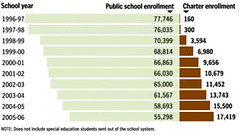Speaking of losing market share
If you follow the decline of the U.S. automobile industry as I do (I feel obligated because I was born in Michigan, plus for a time I worked at the Institute for Social Research at UM as a survey interviewer, including working on the Survey of Consumer Confidence, which has a number of questions about automobile purchasing and use), you know that between the two companies, GM and Ford, they have lost 35+ points of market share over the past 30 years. Today, each point of market share is about 150,000 cars...
I looked more closely at the graphics accompanying today's Post story about charter vs. public schools, "The Future of D.C. Public Schools: Traditional or Charter Education?." If enrollment figures were the basis of determining pay rates, there would definitely be payroll deflation in DC Public Schools.
 Public and charter school enrollment, District of Columbia. SOURCES: D.C. Public Schools, FOCUS Bulletin GRAPHIC: The Washington Post - August 22, 2006.
Public and charter school enrollment, District of Columbia. SOURCES: D.C. Public Schools, FOCUS Bulletin GRAPHIC: The Washington Post - August 22, 2006. Each point of market share is about 723 students. From where I come from, that's the equivalent of a bit more than one elementary school. (My high school had 1200+ students and I don't remember the enrollment of my junior high school.) These days, Ford has proposed a reduction in the number of automobile dealerships selling their marques...
One of the reasons I've always had a hard time believing the school enrollment figures in DC (and the Post numbers do not discuss the review by demographer George Grier back in the mid 1990s, which questioned the figures for the base year used in the above graph) is because in terms of enrollment, the schools are so small. Junior high schools with fewer than 300 students? Elementary schools with fewer than 400 students?
But then the areas with high numbers of school aged children aren't the parts of the city that I normally habituate. So it's not merely a question of observation.
Index Keywords: education



0 Comments:
Post a Comment
<< Home